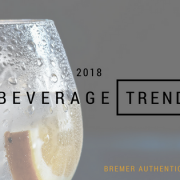As summer heats up, sipping a chilled beverage becomes more appealing. Thus, drink trends are never more important than in the summer months. While last year, slowed-down craft cocktails, frozen rosé (a.k.a. “frozé”), and DIY cold bulletproof coffee were all the rage, this year’s summer drink trends turn a little greener. Functional drinks and cold brews are the two best ways to sum up 2018 beverage trends in the United States.
Functional Drinks and Whole Foods
Functional beverages are “non-alcoholic drinks that keeps one’s body hydrated and provide overall nutritional well-being. These are fortified drinks that prevent or help address health issues across all age groups” (Future Market Insights).
Probiotics and the innovation continuing in “gut health” has pushed brands to take a new approach to wellness through beverage consumption, sparking what looks like a “prebiotic” movement coming onto the scene in late 2018, early 2019. Also, many drinks on the rise make use of spices thought to be detoxifying, like cinnamon, turmeric, and ginger.
Transparent Labeling
As consumers become more and more invested in the idea of food origins, understanding how to articulate to consumers where food comes from will become more important to marketers, as well. You can see this already happening with brands that are willing to even put the origin into the product name, like “Drink Maple.” This strategy seeks to form the bond, with the origin of the product immediately in their brand narrative.
Delivered to your Doorstep
People seeking healthier alternatives via whole foods will be able to find these in increasing numbers through their neighborhood grocery, all the way up to services like Jet.com and Shipt. These services are competing to bring consumers their favorite brands directly to their front porch, as well as take advantage of Amazon’s limitations in cities that are not big enough to benefit from the Amazon/Whole Foods acquisition. If you have a product that is produced locally, and, say, stocked at Target (which is pretty common these days), it can be delivered to your home in minutes. This helps make lesser-known or niche beverage products, even local brands—like in our next trend, cold brew—easier to come by.
Cold Brew Coffee
Coffee has long been king since the mainstream rise of Starbucks. While cold brew coffee is not a new thing, it usually plays second fiddle to its cousin “iced tea,” which is popular in the northeast, and “sweet tea” in the south. The rise of cold brew coffee is tapping into consumer demand for variety, as well as experimental variety. This shows with the rise of products such as blends that are regionally specific, to kegged coffee and nitro technology, to brew-in-a-box technology that allows consumers to buy a “satchel” of coffee and cold brew it at home—much like grandma’s beloved, tried-and-true porch tea you probably remember from your childhood, sitting in the sun seeping all summer long.
Whatever your favored summer beverage may be, you can find easy drinking summer solace close by. And to that, we say: Cheers!
Ingredients for Your Beverage Needs
How can we help your beverage business create your very own trendy drink?
We distribute a variety of food and beverage ingredients you can review here on our website, or via our product line card. Need to make an inquiry or place an order? Call us at 616-772-9100, or send an email anytime.

